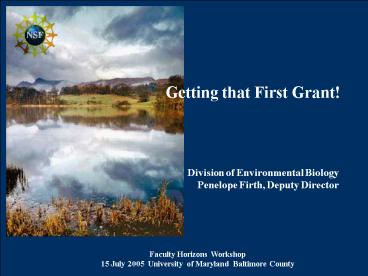Getting that First Grant PowerPoint PPT Presentation
1 / 26
Title: Getting that First Grant
1
Getting that First Grant!
Division of Environmental Biology Penelope Firth,
Deputy Director
Faculty Horizons Workshop 15 July 2005
University of Maryland Baltimore County
2
NSF is a Science Management Agency
Scientists and institutions responding to broad
civilian scientific needs of the nation
40,000 Annual Proposals /Actions
250,000 reviews (50,000 reviewers)
60 advisory groups (6,000 members)
1,200 full-time employees
About 20,000 award actions for 5.5 billion
3
National Science Board
Director Deputy Director
Office of the Director Staff Offices
Office of Inspector General
Directorate for Mathematical And Physical Sciences
Directorate for Biological Sciences
Directorate for Social, Behavioral And Economic
Sciences
Directorate for Computer Information Science
and Engineering
Directorate for Education and Human Resources
Office of Polar Programs
Office of Budget, Finance and Award Management
Directorate for Engineering
Office of Information and Resource Management
Directorate for Geosciences
4
NSF Project Funding Profile
Research Projects 52
Administration Management 5
Education Training 18
Research Centers 6
Research Facilities 19
5
NSF invests in
- IDEAS to provide a deep and broad fundamental
science and engineering knowledge base. - PEOPLE to develop a diverse, internationally
competitive, and globally engaged workforce of
scientists, engineers, and well-prepared
citizens. - TOOLS to provide widely accessible,
state-of-the-art science and engineering
infrastructure.
NSF is an Independent Agency of theExecutive
Branch of the U.S. Government established in 1950
to promote and advance scientific progress in the
United States by sponsoring scientific research
and by supporting selected activities in science
and engineering
6
Getting that First Grant!
- Have a great idea.
- Write a terrific proposal.
- Submit it.
7
David Lester
8
An original idea. An imaginative approach. A
unique question. An important phenomenon. An
exciting conceptual advance.
9
Writing a terrific proposal.
You are NOT here.
10
Necessary elements
- Do your homework.
- Pay attention to the details.
- Get help.
11
Write to show
Demonstrated knowledge and critical analysis of
relevant work by others. Appropriate
experimental, theoretical and/or modeling
approaches. Focused project plan with
contingencies. Experience in essential
methodology and techniques. Feasibility
demonstrated. Track record (established PIs) or
demonstrated potential (new PIs)
12
NSF Funding
www.nsf.gov
13
NSF Guide to Programs
14
NSF Grant Proposal Guide
15
Grant Proposal Guide
Who can submit proposals When and how to submit
proposals How to prepare proposals What kind of
proposals NSF considers Review process Process
for withdrawals, returns, and declinations The
award process and procedures for requesting
continued support Significant grant
administrative highlights
16
Search NSF Awards
17
Dont forget
- Read the Program Announcement
- Become very familiar with the Grant Proposal
Guide - Contact the Program Officer early and often
- Understand the goal of the program
- Learn about eligibility
- Familiarize yourself with special requirements
- Start working with FastLane before the deadline
18
What happens to my proposal once I submit it?
19
Fastlane submission. Compliance checking.
Proposal sent to appropriate programmatic home
Program Officer reads proposal, assigns ad hoc
reviewers, assigns to panel. Panel considers
proposal based on intellectual merit and broader
impacts. Panel makes recommendation. Program
Officers consider panel recommendations and other
factors. Program makes recommendation. Division
Director concurs (or not).
20
NSF Merit Review Criteria
- Intellectual Merit
- Broader Impacts
- As of 1 October 2002, any proposal that does not
address these criteria in the Project Summary
will be - RETURNED WITHOUT REVIEW
21
Intellectual Merit Criterion
- How important is the proposed activity to
advancing knowledge and understanding within its
own field or across different fields? - How well qualified is the proposer (individual or
team) to conduct the project? - To what extent does the proposed activity suggest
and explore creative and original concepts? - How well conceived and organized is the proposed
activity? - Is there sufficient access to resources?
22
Broader Impacts Criterion
- How well does the activity integrate research and
education? - How well does the activity broaden the
participation of underrepresented groups (e.g.,
gender, ethnicity, disability, geographic, etc.)?
- To what extent will it enhance the infrastructure
for research and education, such as facilities,
instrumentation, networks and partnerships? - Will the results be disseminated broadly to
enhance scientific and technological
understanding? - What may be the benefits of the activity to
society?
23
What if my proposal is declined?
24
Famous Quotes
- The difference between a great research project
and a great research project that receives
funding is usually found in the broader impacts - Penelope Firth, 2000
25
All of the information in this talk is available
on the NSF homepage
http//www.nsf.gov
26
Get started!

